In the interest of full disclosure, I have to reveal that while the first three posts of my first full day in Vienna are, as far as I can make them, accurate descriptions of the places as I experienced them and their associated histories, I made some intermediate stops that remained unreported until this post. This was an editorial decision on my part so please be aware of this if the photos in the album I link below seem to be out of sequence.
Love songs, maybe. But have people had enough of silly murals?
Once again, I have to acknowledge the good folks at Atlas Obscura for directing me to this charming little oddity. To reach this spot I made a U-turn out of Judenplatz, passed back through Hoher Markt, and onto Lugeck where I passed a statue honoring Johannes Gutenberg. I stopped long enough to take this photo.
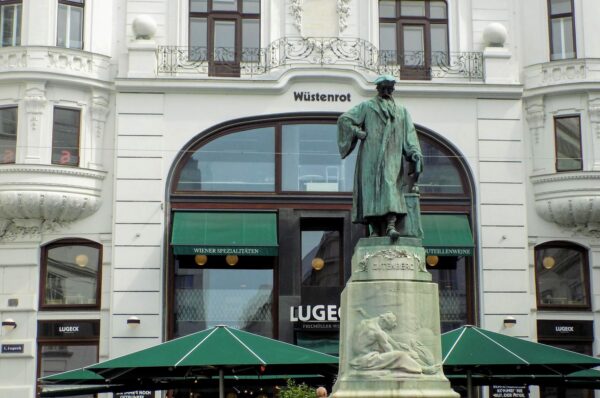
(And if you look closely, you’ll see that the sculptor did capture his spectacular beard.) then continued on my way to Bäckerstraße 12.
According to Atlas Obscura, this house is called Hasenhaus which, given my nominal familiarity with the stew called hasenpfeffer, I’d have translated as Rabbit House but Atlas Obscura uses the more alliterative moniker – “Hare House.” Houses in medieval Vienna commonly had both their exteriors and interiors covered in detailed paintings much like the flourishes found in the borders of illuminated manuscripts of the time. These would have featured historic and religious portraiture, scenes from nature, and often small humorous details in corners of the paintings. In the case of the Hasenhaus, it’s probable that its principal scene featured a rabbit hunt.
Most of these paintings have been lost over time as houses were replaced or simply refurbished. In fact, when the Hasenhaus was restored in the 18th century the only image preserved from the original 1509 painting was this one
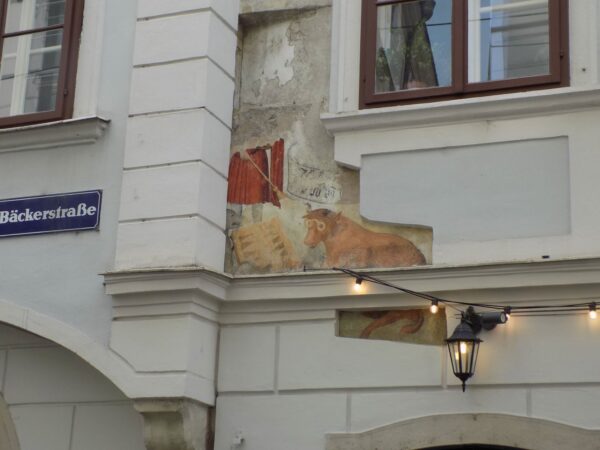
of a spectacles wearing cow engaged in a game of backgammon with a wolf. No one knows what meaning, if any, lies behind it but it’s worth a look if you know it’s there and it certainly made me smile.
The first coincidence.
After the frivolity of a backgammon playing cow, my next stop was to be the home of Elizabeth Báthory at Augustinerstraße 12. On my way, I passed through the section of the Albertinaplatz named Helmul-Zilk-Platz (after a former mayor of Vienna) where I first encountered the Memorial against War and Fascism. It was Zilk who commissioned the Austrian sculptor Alfred Hrdlicka to complete the work for the city in 1988 – the Austrian year of reflection.
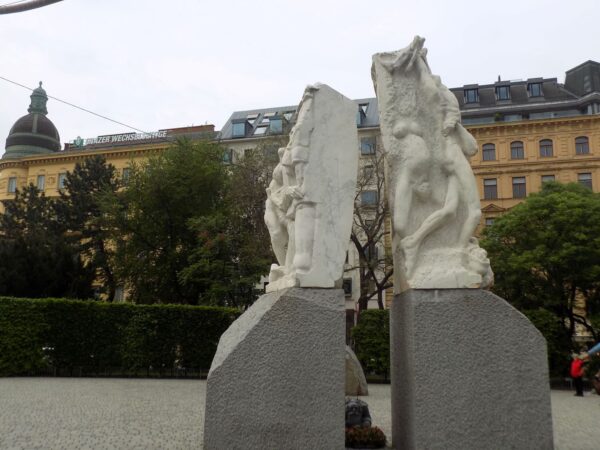
As art often is, it was met with some considerable criticism when it was unveiled on 24 November 1988. Despite a supposed year of reflection leading up to the unveiling of this work, many Austrians remained reluctant to recall Austria’s role in the Second World War particularly since so many had welcomed the Anschluss (annexation) by the Nazis. Others were offended by its location between the Albertina Museum and the State Opera. Still others were troubled by the statement that the work was “dedicated to the memory of all victims of war.” As art – especially controversial or avant-garde art – often does, this work has gained broader acceptance over time.
I suspect you’re wondering about the coincidence. It’s this. After I’d visited the musician’s section of the Zentralfriedhof and taken photos of the graves of some other famous Austrians, I wandered the cemetery taking an occasional picture of graves that caught my eye – sometimes noting but otherwise paying little attention to the identity of the person interred. This
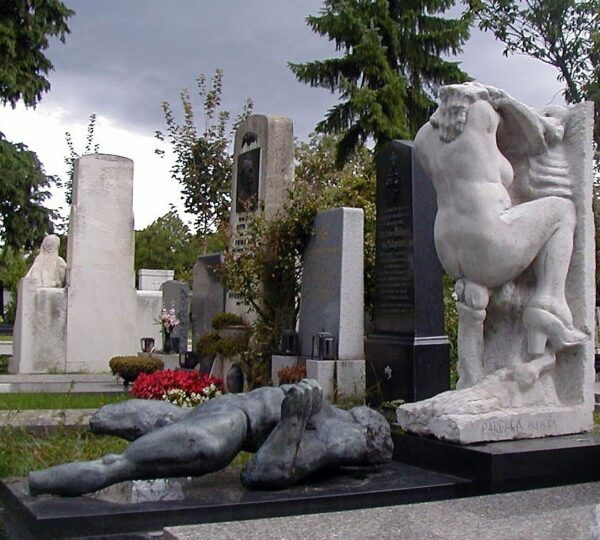
was one of those photos. My note says, “someone named Hrdlicka”. It is, indeed, the grave of Alfred Hrdlicka the creator of the Memorial against War and Fascism with his wife memorialized at his feet. So, in a way, you might say I’d encountered Hrdlicka in death and in life without expecting or planning either.
Some additional wandering until the second coincidence.
I’d arrived in Vienna Friday night not only because I wanted an extra day there but because the first item on the schedule for the Earthbound Expeditions group was (as is often the case) a get acquainted dinner and the only flight from Lisbon that departed at a reasonable hour would have had me arrive too late to share in this. Hrdlicka’s sculpture was probably less than 200 meters from the hotel and, even after walking past the Báthory house, I still had some time before dinner to explore the nearby area. Which I did.
I walked past the National Library, the Hofburg, some other spots, and ended in Maria-Theresein-Platz
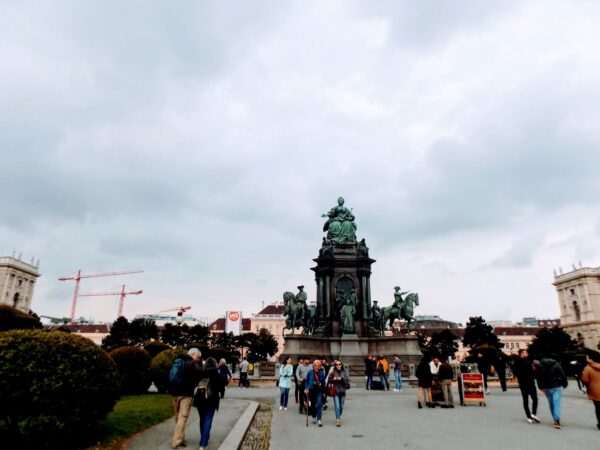
that’s flanked on one side by the Naturalhistoriches Museum (Natural History Museum) and on the other by the Kunsthistoriches Museum (Museum of Fine Arts). It was from here that I decided to straggle back to the hotel and take some time to freshen up.
We met in the lobby, introduced ourselves to one another and answered the questions posed by Shlomit, our tour leader. These were to name a composer with whom we shared an initial of our name and to reveal what it was we were most looking forward to on the trip. As I write this, nearly two months after the trip ended, I don’t recall either of my answers. I will say that for the composer, it was likely Tchaikovsky if I chose my given name or Chopin or Czerny or even Copland if I chose to match my surname. I also know that as I went to bed that night, I hit upon what should have been my answer to the second question. This was that before we left Salzburg I’d have learned how to solve a problem like Maria.
(Note: I recently received a lovely email from Marla, a fellow traveler in our group, who told me that in her memory I was the first in the group to cite composers using both my given name and surname. This certainly coheres with the sort of smart ass behavior to which I am prone. She also noted that in her memory the ‘T’ composer I chose was Telemann and given that he was German, he makes more sense than Tchaikovsky so I’ll defer to her and thank her for being so attentive.)
And now for the second coincidence. Our group dinner that night was at Figlmüller Wien also known as the House of Schnitzel. In Austria and Germany, Wiener Schnitzel is a protected term and must be made with veal. A Figlmüller Schnitzel is made from pork. Of course, I wasn’t about to eat either one but how does one go to the House of Schnitzel and not eat Schnitzel? Fortunately, they had a vegan option on the menu and while I don’t really know what was beneath the breading, I cleaned my plate.
As for the coincidence, the address of Figlmüller Wien is Bäckerstraße 6 and you might recall that the backgammon playing cow is just past the restaurant (or before depending on the direction you’re walking) at Bäckerstraße 12. And now I think I’ve covered my day rather fully.